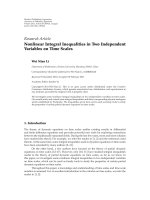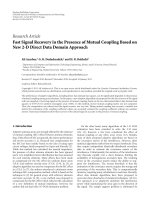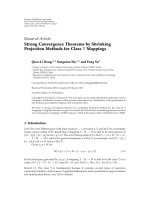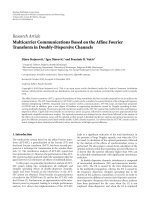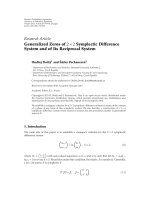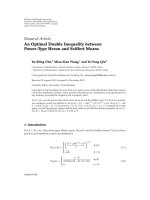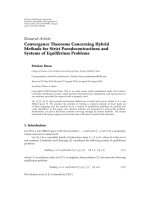Báo cáo hóa học: "Research Article Certain Integral Operators on the Classes M βi and N βi" pptx
Bạn đang xem bản rút gọn của tài liệu. Xem và tải ngay bản đầy đủ của tài liệu tại đây (447.23 KB, 4 trang )
Hindawi Publishing Corporation
Journal of Inequalities and Applications
Volume 2008, Article ID 719354, 4 pages
doi:10.1155/2008/719354
Research Article
Certain Integral Operators on the Classes
Mβ
i
and Nβ
i
Daniel Breaz
Department of Mathematics, 1st December 1918, University of Alba Iulia, 510009 Alba, Romania
Correspondence should be addressed to Daniel Breaz,
Received 13 September 2007; Revised 21 October 2007; Accepted 2 January 2008
Recommended by Vijay Gupta
We consider the classes Mβ
i
and Nβ
i
of the analytic functions and two general integral opera-
tors. We prove some properties for these operators on these classes.
Copyright q 2008 Daniel Breaz. This is an open access article distributed under the Creative
Commons Attribution License, which permits unrestricted use, distribution, and reproduction in
any medium, provided the original work is properly cited.
1. Introduction
Let U {z ∈ C, |z| < 1} be the open unit disk and let A denote the class of the functions fz
of the form
fzz a
2
z
2
a
3
z
3
···,z∈ U, 1.1
which are analytic in the open disk U.
Let Mβ be the subclass of A, consisting of the functions fz, which satisfy the inequal-
ity
Re
zf
z
fz
<β, z∈ U,β>1, 1.2
and let Nβ be the subclass of A, consisting of functions fz, which satisfy the inequality
Re
zf
z
f
z
1
<β, z∈ U. 1.3
These classes are studied by Uralegaddi et al. in 1, and Owa and Srivastava in 2.
Consider the integral operator F
n
introduced by D. Breaz and N. Breaz in 3,havingthe
form
F
n
z
z
0
f
1
t
t
α
1
···
f
n
t
t
α
n
dt, 1.4
where f
i
z ∈Aand α
i
> 0, for all i ∈{1, ,n}.
2 Journal of Inequalities and Applications
Remark 1.1. This operator extends the integral operator of Alexander given by Fz
z
0
ft/tdt.
Also, we consider the next integral operator denoted by F
α
1
, ,α
n
that was introduced by
Breaz et al. in 4,havingtheform
F
α
1
, ,α
n
z
z
0
f
1
t
α
1
···
f
n
t
α
n
dt, 1.5
where f
i
z ∈Aand α
i
> 0 for all i ∈{1, ,n}.
It is easy to see that these integral operators are analytic operators.
2. Main results
Theorem 2.1. Let f
i
∈Mβ
i
, for each i 1, 2, 3, ,n with β
i
> 1.ThenF
n
z ∈Nμ with
μ 1
n
i1
α
i
β
i
− 1 and α
i
> 0,(i 1, 2, 3, ,n).
Proof. After some calculi, we obtain that
zF
n
z
F
n
z
n
i1
α
i
zf
i
z
f
i
z
−
n
i1
α
i
. 2.1
The relation 2.1 is equivalent to
Re
zF
n
z
F
n
z
1
n
i1
α
i
Re
zf
i
z
f
i
z
−
n
i1
α
i
1. 2.2
Since f
i
∈Mβ
i
,wehave
Re
zF
n
z
F
n
z
1
<
n
i1
α
i
β
i
−
n
i1
α
i
1
n
i1
α
i
β
i
− 1
1. 2.3
Because
n
i1
α
i
β
i
− 1 > 0, we obtain that F
n
∈Nμ,whereμ 1
n
i1
α
i
β
i
− 1.
Corollary 2.2. Let f
i
∈Mβ for each i 1, 2, 3, ,n with β>1.ThenF
n
z ∈Nγ with
γ 1 β − 1
n
i1
α
i
and α
i
> 0, i 1, 2, 3, ,n.
Proof. In Theorem 2.1, we consider β
1
β
2
··· β
n
β.
Corollary 2.3. Let f ∈Mβ with β>1. Then the integral operator Fz
z
0
ft/t
α
dt
∈Nδ with δ αβ − 11 and α>0.
Proof. In Corollary 2.2, we consider n 1andα
1
α.
Corollary 2.4. Let f ∈Mβ with β>1. Then the integral operator of Alexander Fz
z
0
ft/tdt ∈Nβ.
Daniel Breaz 3
Proof. We have
zF
z
F
z
zf
z
fz
− 1. 2.4
From 2.4,wehave
Re
zF
z
F
z
1
Re
zf
z
fz
<β. 2.5
So relation 2.5 implies that Alexander operator is in Nβ.
Theorem 2.5. Let f
i
∈Nβ
i
for each i 1, 2, 3, ,n,withβ
i
> 1.ThenF
α
1
, ,α
n
z ∈Nρ with
ρ 1
n
i1
α
i
β
i
− 1 and α
i
> 0, i 1, 2, 3, ,n.
Proof. After some calculi, we have
zF
α
1
, ,α
n
z
F
α
1
, ,α
n
z
α
1
zf
1
z
f
1
z
··· α
n
zf
n
z
f
n
z
2.6
that is equivalent to
zF
α
1
, ,α
n
z
F
α
1
, ,α
n
z
1 α
1
zf
1
z
f
1
z
1
··· α
n
zf
n
z
f
n
z
1
−
n
i1
α
i
1. 2.7
Since f
i
∈Nβ
i
, for all i ∈{1, ,n},wehave
Re
zf
n
z
f
n
z
1
<β
i
. 2.8
So we obtain
Re
zF
α
1
, ,α
n
z
F
α
1
, ,α
n
z
1
<
n
i1
α
i
β
i
−
n
i1
α
i
1
n
i1
α
i
β
i
− 1
1 2.9
which implies that F
α
1
, ,α
n
∈Nρ,whereρ 1
n
i1
α
i
β
i
− 1.
Corollary 2.6. Let f
i
∈Nβ for each i 1, 2, 3, ,n with β>1.ThenF
α
1
, ,α
n
z ∈Nη with
η 1
n
i1
α
i
β − 1 and α
i
> 0, i 1, 2, 3, ,n.
Proof. In Thorem 2.5, we consider β
1
β
2
··· β
n
β.
Corollary 2.7. Let f ∈Nβ with β>1. Then the integral operator
F
α
z
z
0
f
t
α
dt 2.10
is in the class Nαβ − 11 and α>0.
4 Journal of Inequalities and Applications
Proof. We have
zF
α
z
F
α
z
α
zf
z
f
z
. 2.11
From 2.11 we have
Re
zF
α
z
F
α
z
1
α Re
zf
z
f
z
1
1 − α<αβ 1 − α αβ − 11. 2.12
So the relation 2.12 implies that the operator F
α
is in Nαβ − 11.
Example 2.8. Let fz1/2β − 1{1 − 1 − z
2β−1
}∈Nβ. After some calculi, we obtain that
F
α
z
z
0
f
t
α
dt
1
2α1 − β − 1
1 − z
2αβ−11
∈N
αβ − 11
. 2.13
Acknowledgment
The paper is supported by Grant no. 2-CEx 06-11-10/25.07.2006.
References
1 B. A. Uralegaddi, M. D. Ganigi, and S. M. Sarangi, “Univalent functions with positive coefficients,”
Tamkang Journal of Mathematics, vol. 25, no. 3, pp. 225–230, 1994.
2 S. Owa and H. M. Srivastava, “Some generalized convolution properties associated with certain sub-
classes of analytic functions,” Journal of Inequalities in Pure and Applied Mathematics, vol. 3, no. 3, Article
ID 42, 13 pages, 2002.
3 D. Breaz and N. Breaz, “Two integral operators,” Studia Universitatis Babes¸-Bolyai, Mathematica, vol. 47,
no. 3, pp. 13–19, 2002.
4 D. Breaz, S. Owa, and N. Breaz, “A new integral univalent operator,” in press.
